Americans experienced 1344 days of World War II, about three and a half years. Many Americans were defined by those years for the rest of their lives. Some of them even until today.
It defined America. Every candidate for office was questioned about their war record – Kennedy was accused of staying on crutches for far longer than he needed to. Every father was asked what they did during the war. Every man who survived the Battle of the Bulge knew he was alive because someone else died for him and virtually all of them could remember the incident where the other man died. Eventually, the war was handed down like a family legacy to a next generation. Many spat on the inheritance, or so it seemed to veterans.
Others took to the war as a meme. More movies have been made about World War II than any other war. It was the war, and all history of the era was set in the era before or after this particular war.
It replaced the expression ‘antebellum,’ which technically just means before the war but in America refers specifically to before the Civil War. The world changed and put its indelible mark on a whole generation.
And, naturally, World War II was fought over and over in the comic books. It was fought before, during, and after the war. Captain America started fighting before America was in the war. He’s famous for it. But his wasn’t the only comic to do that. Uncle Sam fought the Japanese bombing of Pearl Harbor before Pearl Harbor happened and, yes, Federal Agents asked Quality Comics about that. In August 1941, Quality comics put out Military Comics starring the Blackhawks whose reason for existence was the Nazi invasion of Poland.
The Blackhawks were a team of seven pilots. Though there was a bit of change in the roster, they quickly settled down into Blackhawk himself (not named until many years later), Stanislaus, Chop Chop, Henrickson (Hendy), Andre, Olaf, and Chuck. We’ll get to the importance of those names in a little bit.
Unlike the earlier Justice Society, the Blackhawks had a single, unified identity as a team. They all wore the same uniform, which makes sense because they were a military unit, even if an irregular one. However, Blackhawk himself, as the officer of the group, had a large Blackhawk insignia on his chest.
The uniforms looked like Nazi uniforms. Any Blackhawk could have walked next to Oswald Mosley of the British Union of Fascists in the Battle of Cable Street and not one of the rioters would have thought he was on any side but the BUF.
They flew twin engined planes which could out-fly single engined models. This was unheard of at the time but was actually true. The plane the Blackhawks used was (or was based on) the Grumman XF5F Skyrocket. It was a carrier based plane which was tested against a number of single engined carrier planes.
The Skyrocket could climb like a bat out of hell. They tested it against other planes and the first time they tested climbing capacity the Skyrocket pilot thought the other guy had engine trouble.
The distinguishing features of the Skyrocket, physically, were that the nose of the fuselage did not extend past the wings and it had a twin tail.
The Skyrocket won all its trials. The British-designed and -built Spitfire came a distant second. So the Americans built the Wildcat. Apparently spare parts for the Skyrocket would be difficult to obtain and the plane had chronic landing gear problems. Neither of those problems would ever face a comic book team.
The Blackhawks were not based in Britain, they attacked from Blackhawk Island. This island was located in the far north of the Atlantic Ocean, generally thought to be in the east of that ocean. It was also fairly small. That is almost all we know about Blackhawk Island, though one map was published.
Maybe that’s why it has been so ignored. No superheroes go back to Blackhawk Island, solve a mystery, battle a supervillain who’s taken over, retrieve something, deactivate something: remember that Lady Blackhawk spent years with the Birds of Prey and that never came up.
But Blackhawk Island is possibly more important than people have realized. All the information we have about Blackhawk Island (which isn’t much) matches another mythical island: Thule. This was an island mentioned by ancient writers as being in the far north of the Atlantic Ocean. Like Atlantis, it keeps moving around the place with different people positing it as every island or coast not Britain or Ireland between, roughly, Greenland and an island off Estonia.
The Nazis were fascinated by the legend of Thule. They came up with the notion that the Aryan race evolved on that island, that it was magical and all that stuff. There is the possibility that Blackhawk Island was an anagram for Thule.
Of course, it might be ridiculous that a writer would slip in a northern island and associate it with the Nazis. That would be…Hellboy.
So the Blackhawks went on their missions. Like any comic of the time, it took a while to go from script to publication. So there was no chance they could follow the chronology of the war, and they didn’t bother trying.
The Blackhawks responded to individual villains, groups, and femme fatales like Fear and Lo Chien. The fatales were not always enemies. They also had a lot of Lady Blackhawks, women who wanted to join the Blackhawks but who weren’t good enough, were good enough but changed their minds, or simply disappeared at the end of the story. But beautiful women were always a part of the ethos.
They faced military villains who throughout the war tended to become supervillains. They faced an array of ‘von’ Germans like von Tepp, who bombed the house (later a hospital) where Blackhawk’s younger brother and sister were, killing them. Later the Blackhawks would face von Tepp’s brother, also von Kummel, von Krug, and von Volter.
The Blackhawks also faced groups, including a better than average run of doppelgangers. This makes sense because armies, navies, and air forces largely face their opposite numbers.
But the thing that distinguished the Blackhawks from most of their competitors was the international character of the group.
Blackhawk himself is Polish, as is his second in command, Stanislaus (coincidentally the name of an actual Polish pilot who flew for the British in the Battle of Britain). Hendrickson (usually called Hendy) is Dutch although he was sometimes referred to as German. Andre is French. Olaf is Swedish Chuck is originally the only American and either comes from Texas or Brooklyn (in any event, a place associated with having an attitude). And Chop-Chop is Chinese.
Like most fictional military squads, these people have specialties. Stanislaus is a strongman, Hendy is a sniper, Andre blows things up, Olaf is an acrobat, and Chuck does communications.
For the times this was a very wide-ranging acknowledgment of differing nationalities: a German fighting against Germany would become a cliché in 1960’s movies, but here it should be put against Kato, who went from Japanese to Philippine just so people wouldn’t get upset an American-resident Japanese was fighting against invading Japanese.
The Blackhawks would often often have some catchphrase which would tag their nationality, and their nationalities would be referred to in a very stereotypical way. But it never hurt anybody’s feelings in the stories because they knew they were all friends. I think this is what a lot of kids reading the story took away with them.
So, Olaf would say ‘py yiminy’, Hendy would say ‘himmel’ or ach du lieber’ (expressions which make him German, not Dutch), and the American Chuck would do the same thing with ‘dagnabbit’ and ‘I reckon’. And so on. Their personalities were fairly typical, too. For example, Andre was very attracted to the ladies and successful with them – as people of the time would expect a Frenchman to be.
At a time when people didn’t trust each other across neighborhoods, it was something very different. It was saying all those old images didn’t matter. These people were like those stereotypes but were courageous as individuals and were determined to protect the freedom of all people.
Some might object because these are mere cliches and not real character, and that it’s offensive to put people so indistinguishably into their backgrounds.
And then there was Chop-Chop, who was built like a pot-bellied stove. He was the Blackhawks’s cook. He talked like a typical Chinese comic character of the time. He could not pronounce the letter r (actually, many Chinese couldn’t because that sound is in neither Mandarin nor Cantonese, and people frequently learned languages from books in those days, which did not change their accent). And this was played for laughs.
And yet, like the eighth of the Seven Soldiers of Victory, Wing, Chop-Chop was valuable. He talked funny as he beat the stuffing out of white guys. He rode in Blackhawk’s plane rather than have his own, and he carried a meat clever for a weapon – mind you, he could be deadly with that thing.
Chop-Chop was extremely popular, and got his own solo serial as a backup piece in the Blackhawk comics. No other Blackhawk member got this, not even Blackhawk himself. Were people that offensive that they made the one Chinese member a clown?
I think he represented something to readers. He speaks inarticulately, but it matches a guileless personality. Chop-Chop seems to be almost a stranger to deceit. And despite finding the world against him, he refuses to become cynical. He is cheated and is always surprised when he is. ‘I been double clossed’ as he once shouts. And his emotions are on his sleeve. Compare that to Lo Chien, who is virtually saturated with her sense of superiority.
I don’t like it, I prefer the later Chop-Chop, when he is called Wu Chen. I don’t like when they call him Dr Hands because he hits things with full glove brass knuckles over his martial arts. Nothing against brass knuckles, just does every Asian knows martial arts? No exceptions? None of them learn savate? Boxing? Wrestling? Always a martial art?
I think the intention was to lighten the drama. Chop-Chop is to the Blackhawks what Ebony is to the Spirit. I don’t like either of them, so let’s move on.
After the war, Nazis were hard to find. But the Blackhawks continued. They fight Communists and increasingly battle science fiction villains. They change from Skyrockets to various kinds of jet. But there is a scent of the past about them. DC’s solution was to change them to red-and-black shirts and green pants and put the Blackhawk symbol on everyone’s chest. They looked at lot more like superheroes and superheroes were the way to go.
DC decided that wasn’t far enough, so they gave Blackhawks their own superhero identities. Let’s ignore that whole episode, DC should have put them in stasis on Blackhawk Island until the world needed them again. Or possibly they should have been made into an Ice Hockey team.
It would have been interesting if they’d become an ice hockey team.
It was getting along though ethnically diverse that was the key to the Blackhawks. That was what made the Blackhawks different, so they did it again.
After the war, the war just wouldn’t go away. It became a set of tropes in its own right, and the tropes which were used leading up to the war faded from memory. The Great Depression was the source of many elements of movies and books before the War, but the War blew them away like so much topsoil in a dustbowl era.
In 1963, at a time he was doing so much else, Stan Lee tried to write a failure of a comic book. He failed. Sgt Fury and His Howling Commandos was a success. In interviews through the years, Stan Lee said he thought ‘Howling’ and ‘Commandos’ were both too long to make a good title.
He also said he told staff they could have some fun doing the comic. He seems to have told staff ‘fun’ as a reason for everything they did.
The Howling Commandos are, like the Blackhawks, a military unit. The starting artist was Jack Kirby, and he was in the infantry during World War II, so the uniforms and weaponry are what they should be: Thompson submachine guns, two 30 round box clips, and so on. Later artists, perhaps imitating what Kirby drew, tended to keep the right uniform and weapons – mostly.
The Howling Commandos are an elite unit, as shown by the fact even privates have Thompsons. In real life, they were too expensive for privates, who tended to have M1 carbines, and the Thompsons were reserved for Corporal on up, tank crews, and those engaging the Germans in their own territory. That, of course, includes the Howling Commandos.
The idea that the war was ‘really’ about Axis racism versus allied tolerance had taken hold. This totally ignored the fact the federal authorities knew they couldn’t win the war without the full support of American blacks. So they told Hollywood to create the ‘new Negro.’ They let blacks fly planes – they flew P51s with tails painted red. Between the Red Tails, Checkerboards, and P-38s, the B-17 crews they were protecting preferred the Red Tails.
In 1943 a Red Tail had to make an emergency landing with the B-17s. They learned he was black, like all Red Tails. Incidents like that started breaking down walls.
In the 1948, Eisenhower ordered the American armed forces integrated. He did it by an Executive Order (which should be remembered when people complain that those even exist).
He didn’t think he could get the Congress to agree to it.
The Howling Commandos are a mix of cliché, history, and a new world that was beginning to emerge.
Like the Blackhawks, the new group has seven members. Also like the Blackhawks, they change members. But in this case readers see people die. Readers also see some of the issues of World War II. For example, a new recruit who isn’t really ready is sent to Fury’s unit, he cracks under the pressure, and is executed.
Depending on the politics of the person you’re talking to, that’s the way it was always done or that’s a load of garbage.
It seems the American military forces were inconsistent in how they treated men who collapsed. Some were sent behind the lines where Patton could slap them and get punished for it, some were shot for desertion. It’s one of those moral skeins that will never be pulled apart.
However, unlike their predecessors, the Commandos face a lot of moral issues about what is justified – or even just excusable – in a war. This was a series of stories written after the war, when such questions arise. It was a more thoughtful form of story, but it retained the idea that differences which team up succeed better. The idea is still percolating through every kid sports movie and the ghost of it is in every call for diversity.
The seven members show different aspects of American culture. Sergeant Nick Fury is from Hells Kitchen, New York. He is based on John Wayne and talks like a cowboy. There aren’t the femme fatales the Blackhawks had, but Fury had a girlfriend who, like Blakhawk’s sister, was a nurse. She got bombed to bits by the Nazis, just like Blackhawk’s sister.
His corporal, Dum Dum Dugan, is an Irish American from Boston who likes neither his wife nor his mother-in-law and was previously a circus strongman. Every unit in a story needs one of those, the Blackhawks have Staislaus.
Izzy Cohen is Jewish, which in the comics doesn’t kill him when he goes to Germany. He is also a mechanic.
Gabriel Jones is black and plays the trumpet. It’s still cliche but mot out of proportion to any other character. He’s not like Chop-Chop.
Dino Manelli is modeled after Dean Martin and in the stories once had a comedy partner, Jerry Larkin, based on Jerry Lewis.
Rebel Ralston is from Kentucky and has no problems with Gabriel Jones. Yet calling him ‘Rebel’ would probably not be acceptable today, given recent objections to a Confederate flag.
Junior Juniper was killed off quickly, as is Andre in the Blackhawks. Except Andre comes back and Juniper never does.
Juniper is replaced by a British soldier, Pinky Pinkerton, who was based on John Steed in the British show, The Avengers. His specialty is fighting with an umbrella and blowing things up like Andre in the Blackhawks. Recently they decided he was gay all along at least partly because he didn’t dress like a slob in a manner that would in real life get you doing pushups until your eyes fell out.
The stories did not have the cliché references to each others’ cliche characteristic, though when Nick Fury tells people to get the lead out he does talk like a John Wayne cowboy. There is a more muted acceptance. In the Howlers, they do have a transient racist who doesn’t like the black guy or the Jewish guy, but at the end comes to an accommodation with both of them.
The writers the Howling Commandos had one advantage over writers of the Blackhawks. They knew what was happened in the war and could do stories which one built off the other. So they could put World War II into the periods of Battle of Britain, D-Day, and the drive for Berlin. The Howlers showed no concern about the invasion of Poland.
As the hippy-trippy sixties gave was to the dull edge of seventies economics, Sgt Fury began to have a Justice Society problem. World War II was drifting from people’s minds, and the veterans were getting old. World War II was no longer anchored by the memories of men who had survived, because they could not survive forever.
Tellingly, the Howlers and the Blackhawks ran into the same problems at the same time. The difference was the Howlers did not try to become superheroes in the World War II era. Arguably, they did it twenty years later, story time. They brought Nick Fury ‘back’ as a Colonel for a spy series where the organization had one of those acronym names: SHIELD. It faced a revived Nazi-style organization which also had an acronym name: HYDRA.
The Howlers themselves, though, did not maintain their energy. The Howling Commandos went into reprints, and then stopped altogether.
The Colonel became more important than the Sergeant. Long lived guest stars like Thor and Captain America proved to be a shot in the arm of sales that quickly wore off. The Howling Commandos were losing relevance even as the Blackhawks were going into their idiot superhero stunt.
The Colonel of SHIELD was not immune to this. But unlike the Fantastic Four, Marvel could not simply stop mentioning service in WWII for Sergeant Fury or Colonel Fury. They were trapped by their origin. They were not men of the times but of some other time.
Colonel Fury battles his brother who is the supervillain, Scorpio, who is a homosexual who has a relationship with a Life Model Decoy of Colonel Fury. He commits suicide while listening to Somewhere Over the Rainbow.
He pronounced the letter r correctly.
Nick Fury and the Howling Commandos who were left did not age. This became more and more of a problem and age retarding drugs were not enough of an explanation. Eventually he was replaced with someone with the same name, Samuel L Jackson, and the problems the new Colonel Fury faces are purely modern. Sergeant Fury has been put in mothballs.
For most people, World War II has faded from memory, and the people who went through it are fading from our population. But in comics like the Blackhawks and the Howling Commandos we can remind ourselves there was a time when force was put to the service of justice rather than force simply being a means to power, when freedom and tolerance went together, and that was a burden carried by all. Dip into the comics and remind yourself a whole people can do great things, each and every one of them.







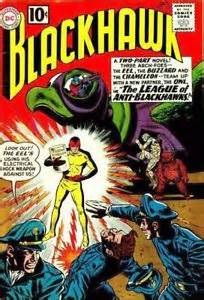
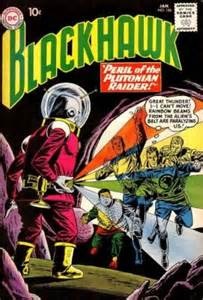
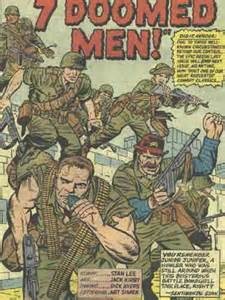
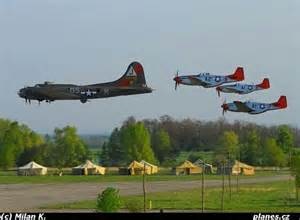
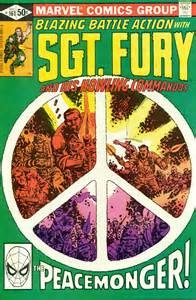
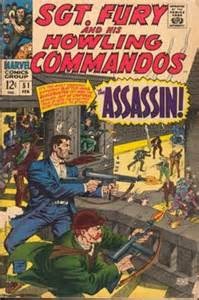
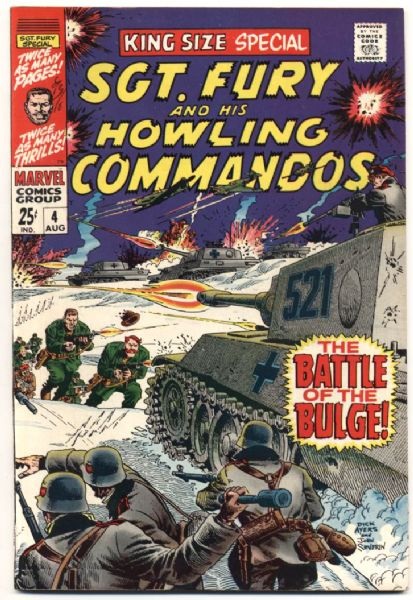
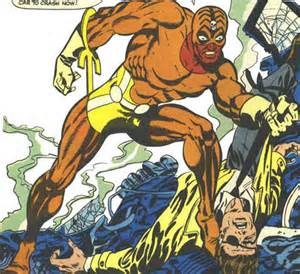
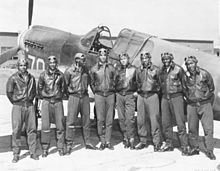
Comments are closed.